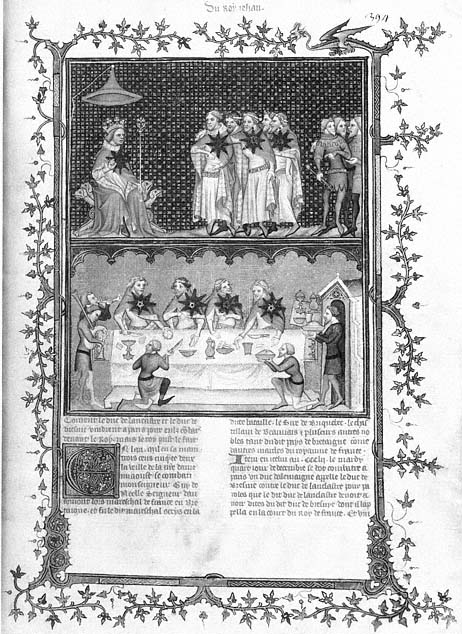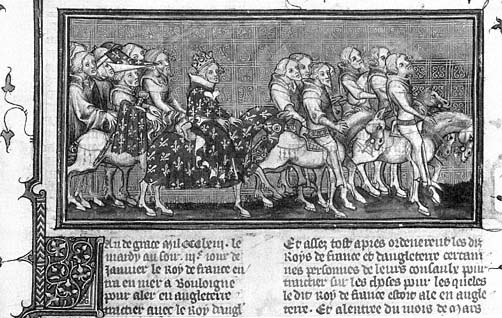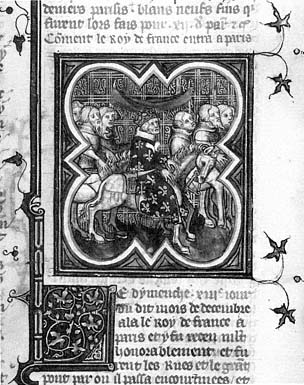Kingship and Internal Politics
Textual changes in the first continuation of Charles V's Grandes Chroniques promote ideals of kingly behavior in the context of contemporary political rivalries, exaggerating English misconduct and minimizing French deficiencies. When Raoulet d'Orléans continued Henri de Trévou's text, he substituted four rewritten pages for the last few folios of the life of Philip of Valois and made editorial changes in the first part of the same gathering.[2] Almost all the leaves immediately preceding
the substitution are corrected more carefully than in the first portion of the book. In fact, three folios before the change of scribe, a sizable paragraph dealing with the abbey of Saint-Denis is crossed out emphatically and a red vacat (void) penned in its margins (fol. 383). This unflattering paragraph refers to Philip of Valois's request for the abbey's gold crucifix as a war subsidy despite a papal inscription on its base threatening excommunication of the person who dared remove it from the abbey.[3] This account of kingly greed, like the account of Hugh Capet's jealousy in the first portion of the chronicle, was probably deemed unsuitable in a royal commission.
A few folios later, in the substituted text, an elaborate description of the siege of Calais reveals a more extensive example of pro-French editing. Later versions of the Grandes Chroniques contain the text that probably originally existed in Charles's manuscript. They simply state that Philip of Valois arrived too late to help the residents of Calais, who surrendered because they had nothing to eat.[4] This book, however, stresses the "great care and diligence" with which Philip tried to help the city; the wickedness of the English king, who broke a treaty to continue the siege; and the suffering of the people of Calais, reduced to eating horses, cats, dogs, and rats, before their surrender.[5]
Like these texts, prominent images also promote French superiority over the English. They laud the kingly behavior of John the Good and denigrate the English. For example, one of the most striking miniatures in this portion of the Grandes Chroniques , a picture of the meeting and feast of the Order of the Star (Fig. 76), illustrates a chapter that describes the treachery of the English, who broke a treaty with the French to capture the city of Guines.[6] This picture commands the reader's attention by its position and scale; it follows the text that it illustrates, and it is one of only three miniatures in the whole manuscript that fill three-quarters of a page each.[7]
The rubric to this chapter suggests that the miniature of the Order of the Star is related to the text that precedes it. In Charles V's manuscript the traditional rubric for the third chapter of John the Good's life, "How the city and castle of Guines were captured by the English, the day that the king of France celebrated with the Order of the Star at Saint-Ouen," is expanded to include the phrase, "which feast is portrayed and illustrated below."[8]
The picture illustrates a discussion between the king and several members of the order on the occasion of a feast. Regarding this episode, the text simply states that John the Good founded the order in October 1351 and that the members wore stars on their hoods or mantles. The picture, on the other hand, includes more specific details of costume: white tunics, red mantles, pearl-studded fillets that the participants tied around their foreheads, and complicated stars.[9]
Because the order no longer existed in the 1370s, this image is an archaeological reconstruction. Both the royal accounts relating to the execution of elements of costume and John the Good's ordinance sent to a group of nobles and princes in 1351 to recruit members offer proof that the costumes included in the painting were authentic.[10] Thus, when this miniature was painted, more than 20 years after the event, the artist incorporated evidence derived either from an eyewitness account of the events or from court documents.[11]
Why lavish so much attention on a miniature that not only departs from traditional placement and scale but also addresses a subject of apparently little

Figure 76
Order of the Star. Grandes Chroniques de France . Bibliothèque Nationale,
Ms. fr. 2813, fol. 394. Photograph: Bibliothèque Nationale, Paris.

Figure 77
John the Good enters London. Grandes Chroniques de France . Bibliothèque Nationale, Ms. fr.
2813, fol. 438. Photograph: Bibliothèque Nationale, Paris.
significance to the text? The answer lies in the motivation for the founding of the order and in the contemporary perception of its goals. The full title of the order, Company of Knights of Our Lady of the Noble House at Saint-Ouen, gives a clue to its purpose.[12] To create a tighter bond between John and members of the nobility, the order intertwined the cult of the Virgin with a series of regulations that restricted the conditions under which a member could do battle. Ties like the one created by this order became increasingly necessary for the French as loyalties shifted during the Hundred Years' War.
Even more important to an understanding of this picture, however, is the relationship between the Order of the Star and the English Order of the Garter, founded by Edward III.[13] The rules and goals of these orders changed in response to each monarch's need to ensure the loyalty of his troops and, more important, in response to developments on the other side of the channel. Thus the Order of the Star, founded approximately three years after its English counterpart, was a rallying point for French chivalry—a political statement expressing clear opposition to the English and perhaps responding to the Order of the Garter.
The relationship between this miniature and its text confirms the political interpretation of the Order of the Star in France. While the text focuses on the neglect of a treaty by the English and their use of treachery to capture a city, the miniature presents a picture of the victorious French king united with his loyal knights, who stand in opposition to those who threaten the realm. Thus French virtue is contrasted with English decadence.
The only other two-column miniature featuring John the Good offers a more specific glorification of kingly behavior. John's royal entry into London in 1363 (Fig. 77) marked his willing return to captivity after Louis, duke of Anjou,

Figure 78
John the Good enters Paris. Grandes Chroniques de
France . Bibliothèque Nationale, Ms. fr. 2813, fol. 436v.
Photograph: Bibliothèque Nationale, Paris.
John's second son and one of the hostages who had taken the king's place in England in 1360, returned to France without permission. This breach of honor, coupled with France's difficulty in meeting ransom payments, broke the Treaty of Brétigny. For John the Good, the only honorable recourse was to return to London.[14] The scale of this miniature highlights the importance to Charles V of his father's honorable behavior. The miniature depicting John's royal entry into Paris when he was released in 1360 (Fig. 78) is of normal size. Only his voluntary return to captivity, a gesture lauded by the French, is shown in large scale.[15]